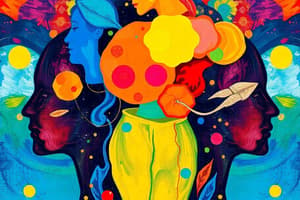Podcast
Questions and Answers
What is defined as the completion of structural changes and the attainment of the capacity to function like a normal adult?
What is defined as the completion of structural changes and the attainment of the capacity to function like a normal adult?
- Maturity (correct)
- Development
- Motor Development
- Growth
Which principle describes the progression from gross motor skills to specific motor skills?
Which principle describes the progression from gross motor skills to specific motor skills?
- Hierarchical integration
- Bilateral to unilateral
- Mass to specific trend (correct)
- Cephalo-caudal to proximo-distal
What aspect of development refers to changes related to emotions throughout a person's growth?
What aspect of development refers to changes related to emotions throughout a person's growth?
- Social Development
- Emotional Development (correct)
- Cognitive Development
- Motor Development
Which developmental approach focuses on the study from the origin of species to humans?
Which developmental approach focuses on the study from the origin of species to humans?
What type of development refers to the physical and social abilities that help an individual interact with their environment?
What type of development refers to the physical and social abilities that help an individual interact with their environment?
What type of motor skill involves complex behavioral patterns and coordination of several reflexes in neonates?
What type of motor skill involves complex behavioral patterns and coordination of several reflexes in neonates?
At the preschool level, which of the following is NOT a stage of motor development?
At the preschool level, which of the following is NOT a stage of motor development?
During late childhood, what tends to happen to basic motor skills?
During late childhood, what tends to happen to basic motor skills?
Which of the following is a common decline in motor skills with age?
Which of the following is a common decline in motor skills with age?
Which theory proposes that handedness is influenced by social learning?
Which theory proposes that handedness is influenced by social learning?
Neonates only exhibit specific reactions to internal and external stimuli as their type of motor skills.
Neonates only exhibit specific reactions to internal and external stimuli as their type of motor skills.
At the preschool level, jumping and writing are considered complex motor skills.
At the preschool level, jumping and writing are considered complex motor skills.
During adolescence, eye-hand coordination and speed typically decline.
During adolescence, eye-hand coordination and speed typically decline.
Diminishing fine motor skills is a sign of decline in motor function with age.
Diminishing fine motor skills is a sign of decline in motor function with age.
Handedness is solely achieved through social learning.
Handedness is solely achieved through social learning.
Match the following types of development with their descriptions:
Match the following types of development with their descriptions:
Match the following principles of motor development with their descriptions:
Match the following principles of motor development with their descriptions:
Match the following terms with their meanings:
Match the following terms with their meanings:
Match the following stages of motor development with their characteristics:
Match the following stages of motor development with their characteristics:
Match the following characteristics of gross motor skills with the correct descriptions:
Match the following characteristics of gross motor skills with the correct descriptions:
Flashcards are hidden until you start studying
Study Notes
New Terms in Developmental Psychology
- Growth: Quantitative changes; e.g., brain size and body weight increase.
- Development: Qualitative changes leading towards maturity, involving orderly progression.
- Maturity: Completion of structural changes enabling normal adult physical and mental functioning; e.g., brain maturation.
- Phylogenetic: The study from the origin of species to present-day humans.
- Ontogenetic approach: The study of an individual's development from inception to death.
Types of Development
- Motor Development: Involves physical skills from infancy through maturity.
- Emotional Development: Includes the evolution of feelings and emotional responses.
- Social Development: Focuses on understanding and practicing social behaviors and norms.
- Cognitive Development: Concerns intellectual growth and the development of thinking.
Motor Development
- Importance: Crucial for interacting with the environment; inadequate development can lead to psychological issues (e.g., inferiority, shyness).
- General Principles:
- Mass to Specific: Development from gross to fine motor skills (e.g., walking to writing).
- Large to Small Muscles: Progression from full body movements to smaller muscle activities (e.g., grasping).
- Cephalo-Caudal to Proximo-Distal: Control develops from head to toe and from center to extremities.
- Bilateral to Unilateral: Coordination progresses from using both sides to one side of the body.
- Hierarchical Integration: Sequential development (e.g., learning to sit before standing).
Early Motor Development
- Neonate Skills: Exhibits random activities, reflexive movements, complex behavioral patterns.
- Pre-school Level: Development of loco-motor behavior, manipulative skills, and complex motor activities.
Motor Development in Late Childhood and Adolescence
- Late Childhood (7-13 years): Refinement of basic motor skills; improved smoothness and speed.
- Adolescence (14-20 years): Increased reaction time, improved coordination and athletic performance.
Decline in Motor Skills with Age
- Aspects of Decline: Reduced reaction time, delayed nerve conduction, decreased speed and smoothness in movement, unsteady gait, diminished fine motor skills.
Handedness
- Definition: Preference for one hand in motor activities.
- Theories: Structural and social learning influences on handedness.
Emotional Development
- Key Terms:
- Feelings: Internal states (e.g., sadness).
- Emotions: External expressions of feelings (e.g., crying).
- Affect: Persistence of emotions over time.
- Components of Emotions: Physiological arousal, voluntary behavior, phenomenological experience.
Characteristics of Emotional Behaviors
- Duration, intensity, frequency, and control vary across age groups from children to adults.
Social Development
- Definition: Development of socialization skills and ability to conform to social expectations.
- Socialization Processes: Proper behavior, playing social roles, and developing social attitudes.
- Patterns of Development: Progress from lack of social awareness to peer adjustment, established group relations, and school socialization.
Social Development Stages
- Infancy (0-2 years): Characteristics include imitation and shyness.
- Preschool (2-6 years): Dominated by aggression and friendliness.
- Late Childhood (6-11 years): Over sensitivity, rivalry, and social responsibility.
- Puberty (11-16 years): Antisocial behaviors, isolation, and authority resistance.
- Adolescence (16-20 years): Transition to adulthood with focus on appearance and social groups.
- Adulthood: Preoccupation with work, family, and civic engagement.
- Old Age: Adjustment to retirement and family dynamics.
Factors Influencing Social Behavior
- Family dynamics, parental attitudes, physical conditions, illnesses, and peer interactions impact social development.
Cognitive Development
- Intellectual Growth: Evolution of intelligence from childhood to adolescence and decline with age.
- Piaget's Theory: Framework for understanding cognitive development stages through interaction with the environment.
Early Motor Development
- Neonate Motor Skills: Exhibits random activities, specific reflexive reactions, and complex behavioral patterns coordinating various reflexes.
- Preschool Motor Development Stages:
- Locomotor Behavior: Includes actions like walking.
- Manipulative Behaviors: Involves reaching and grasping.
- Complex Skills: Developing skills such as jumping, climbing, and writing.
Late Childhood and Adolescence Motor Development
- Late Childhood (7-13 years): Limited investigations; enhancement of basic motor skills, including refinement and increased speed.
- Adolescence (14-20 years): Limited studies; marked improvement in reaction time, eye-hand coordination, and athletic performance.
Decline with Age
- Effects of Aging:
- Reduced reaction time.
- Delayed nerve conduction.
- Decreased locomotor speed and smoothness.
- Unsteady gaits.
- Declining fine motor skills.
Handedness
- Definition: Preference for one hand in motor tasks.
- Theories of Handedness:
- Structural Theory: Focuses on brain anatomy.
- Social Learning Theory: Emphasizes the influence of environment and learning.
Emotional Development
- Key Terms:
- Feelings: Internal, non-expressive emotions (e.g., sadness).
- Emotions: Expressive components of feelings (e.g., laughing).
- Affect: Longevity of emotions (e.g., persistent sadness).
Components of Emotions
- Physiological Arousal: Involves autonomic nervous system reactions.
- Voluntary Behavior: Includes facial muscle movements.
- Phenomenological Experience: Conscious awareness of thoughts and feelings.
Characteristics of Emotional Behavior
- Duration, Intensity, Shift, Frequency, Control: Emotional behaviors evolve from brief, intense reactions in childhood to prolonged and controlled expressions in adulthood.
Social Development
- Definition: Development of socialization skills to meet societal expectations.
- Socialization Processes: Includes performing socially accepted behaviors, taking social roles, and developing social attitudes.
Pattern of Social Development
- Begins with minimal group feelings, moves to partial adjustment with peers, and culminates in established group relationships in late childhood.
Social Behavior Characteristics
- Infants (0-2 years): Show behaviors like imitation, shyness, and rivalry.
- Preschool Children (2-6 years): Characterized by negativism, aggression, and friendliness.
- Late Childhood (6-11 years): Features like over-sensitivity, rivalry, and sportsmanship.
- Adolescents (11-16 years): Marked by antisocial tendencies, resistance to authority, and isolation.
- Adulthood: Focus shifts to work, family, and civic activities.
- Old Age: Adjustment to retirement and family social dynamics.
Factors Influencing Social Behavior
- Family dynamics, parental attitudes, physical and physiological conditions, illnesses, and peer interactions.
Cognitive Development
- Intellectual Development:
- Evolution of Intelligence: Definition and conceptualization influences understanding of intelligence.
- Growth Patterns: Rapid growth in early childhood, slower changes during 12-13 years, and stabilization around 16-20 years.
- Decline: After age 20, intelligence declines with notable hereditary influence.
Piaget’s Theory of Cognitive Development
- Key Components: Integration of biology and epistemology; adaptation, assimilation, accommodation, and organization are core functions in cognitive development.
Key Concepts in Developmental Psychology
- Growth: Quantitative changes such as increases in brain size or body weight.
- Development: Qualitative changes leading towards maturity through a coherent process.
- Maturity: Completion of structural changes, enabling typical functioning of adults, exemplified by brain maturation.
- Phylogenetic: Studies evolutionary progress from species origin to humans.
- Ontogenetic Approach: Focused on individual development from inception to death.
Types of Development
- Motor Development: Refers to the progression of physical movement abilities.
- Emotional Development: Encompasses the evolution of emotional understandings and expressions.
- Social Development: Involves acquiring socialization skills and meeting societal expectations.
- Cognitive Development: Focuses on intellectual growth and cognitive processes.
Motor Development
- Importance: Essential for controlling physical and social environments; inadequate development can lead to psychological issues like inferiority and withdrawal.
- General Principles:
- Mass to Specific: Development progresses from gross to fine motor skills.
- Large to Small Muscles: Development starts with big muscle involvement and narrows to specific areas.
- Cephalo-Caudal to Proximo-Distal: Progression occurs from head to extremities, and from central to peripheral body parts.
- Bilateral to Unilateral: Skills develop bilaterally before becoming unilateral.
- Hierarchical Integration: Motor skills build on one another in a sequential manner.
Early Motor Development
- Neonate Skills: Encompasses random full-body movements, reflexive responses, and coordinated reflex patterns.
- Pre-school Development Stages:
- Loco-motor: Walking and basic movement.
- Manipulative: Grasping and reaching.
- Complex Skills: Development of jumping, climbing, and writing.
Motor Development in Later Childhood and Adolescence
- Late Childhood (7 to 13 years): Refines motor skills; increases smoothness and speed.
- Adolescence (14 to 20 years): Improvement in reaction time, hand-eye coordination, and athletic performance.
Decline with Age
- Aging Effects: Includes reduced reaction time, delayed nerve conduction, decreased locomotor speed and smoothness, unsteady gaits, and diminished fine motor skills.
Handedness
- Definition: Preference for one hand in motor activities.
- Theories: Achieved through structural development or social learning.
Emotional Development
- Key Terms:
- Feelings: Internal, non-expressive emotional states like sadness or happiness.
- Emotions: External expressions of feelings such as laughter or tears.
- Affect: Persistence of emotions over time.
- Components of Emotions:
- Physiological Arousal: Involves autonomic nervous system reactions.
- Voluntary Behavior: Facial muscle movements as expression.
- Phenomenological Experience: Conscious awareness of feelings and thoughts.
Characteristics of Emotional Behavior
- Duration: Emotions in children are brief; adults experience longer-lasting emotions.
- Intensity: Children have less graded intensities compared to adolescents and adults.
- Shift: Children exhibit fast shifts while adults show minimal shifts in emotions.
- Frequency: Children experience emotions more frequently; the occurrence decreases with age.
- Control: Children show no inhibition; adults exhibit greater control over emotional responses.
Social Development
- Socialization Definition: Development of social skills and acquiring behaviors that align with social expectations.
- Processes: Includes proper behavior performance, playing approved social roles, and maturation effects.
- Factors Influencing Social Behavior: Family dynamics, parental attitudes, social interactions, and physiological conditions.
Social Development Across Life Stages
- Adolescence (16-20 years): Transition period marked by adjustments in habits, educational choices, and social groups.
- Adulthood: Preoccupation with work, family, and civic engagements.
- Old Age: Focus on adjustments to retirement and social activities.
Cognitive Development
- Evolution of Intelligence: Dependent on definitions and conceptualizations. Weschler defines it as capacity to think and adapt purposefully.
- Growth Patterns:
- Rapid growth in early childhood; stabilizes around 12-13 years; generally ceases by 16 to early 20s.
- IQ remains stable throughout childhood and adolescence, can predict adult intelligence.
- Decline with Age: Begins after 20, characterized by a reduction in 'g' factor intelligence with hereditary factors playing a role.
Piaget’s Theory of Cognitive Development
- Focuses on the integration of biology and epistemology, outlining cognitive functions such as adaptation, assimilation, accommodation, and organization.
- Schema Development: Results from cognitive interactions and functions.
Studying That Suits You
Use AI to generate personalized quizzes and flashcards to suit your learning preferences.




